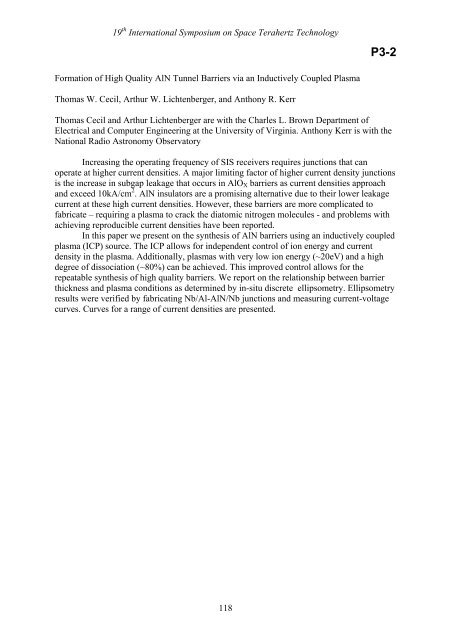Program and Abstract Book - SRON
Program and Abstract Book - SRON
Program and Abstract Book - SRON
Create successful ePaper yourself
Turn your PDF publications into a flip-book with our unique Google optimized e-Paper software.
19 th International Symposium on Space Terahertz Technology<br />
P3-2<br />
Formation of High Quality AlN Tunnel Barriers via an Inductively Coupled Plasma<br />
Thomas W. Cecil, Arthur W. Lichtenberger, <strong>and</strong> Anthony R. Kerr<br />
Thomas Cecil <strong>and</strong> Arthur Lichtenberger are with the Charles L. Brown Department of<br />
Electrical <strong>and</strong> Computer Engineering at the University of Virginia. Anthony Kerr is with the<br />
National Radio Astronomy Observatory<br />
Increasing the operating frequency of SIS receivers requires junctions that can<br />
operate at higher current densities. A major limiting factor of higher current density junctions<br />
is the increase in subgap leakage that occurs in AlO X barriers as current densities approach<br />
<strong>and</strong> exceed 10kA/cm 2 . AlN insulators are a promising alternative due to their lower leakage<br />
current at these high current densities. However, these barriers are more complicated to<br />
fabricate – requiring a plasma to crack the diatomic nitrogen molecules - <strong>and</strong> problems with<br />
achieving reproducible current densities have been reported.<br />
In this paper we present on the synthesis of AlN barriers using an inductively coupled<br />
plasma (ICP) source. The ICP allows for independent control of ion energy <strong>and</strong> current<br />
density in the plasma. Additionally, plasmas with very low ion energy (~20eV) <strong>and</strong> a high<br />
degree of dissociation (~80%) can be achieved. This improved control allows for the<br />
repeatable synthesis of high quality barriers. We report on the relationship between barrier<br />
thickness <strong>and</strong> plasma conditions as determined by in-situ discrete ellipsometry. Ellipsometry<br />
results were verified by fabricating Nb/Al-AlN/Nb junctions <strong>and</strong> measuring current-voltage<br />
curves. Curves for a range of current densities are presented.<br />
118
















